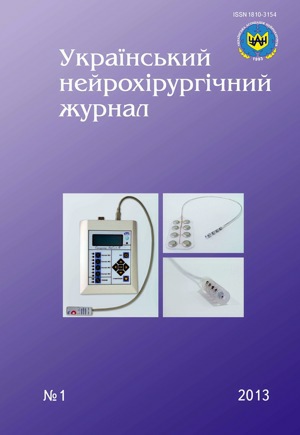Cerebral blood flow and cerebral saturation in head injury. Comparison of CT perfusion and cerebral near-infrared oxymetry
DOI:
https://doi.org/10.25305/unj.55539Keywords:
head injury, cerebral near-infrared oxymetry, perfusion computed tomographyAbstract
Background. The purpose of this study was to determine the relationship between cerebral tissue oxygen saturation and cerebral blood volume in patients with traumatic brain injury.
Materials and methods. Perfusion computed tomography of the brain was performed in 27 patients with traumatic brain injury associated with simultaneous SctO2 level measurement using cerebral near-infrared oxymetry. The mean age of the injured persons was (34,5±15,5) years, 14 men, 13 women. The Injury Severity Score (ISS) values were 44,7±8,3 (25–81). The Glasgow Coma Score (GCS) mean value before the study was 10,3±1,9(5-13).
Results. SctO2 varied between 51 and 89%, mean (62,1±8,3)% (left frontal lobe) and (61,3±5,1)% (right frontal lobe). Cerebral blood volume (CBV) values were (2,3±0,63) ml/100 g, cerebral blood flow (CBF) was (31,7±13,4) ml/100 gЧmin, mean transit time (MTT) values were (5,3±3,4) s, the time to peak (TTP) was (21,2 ± 2,1) s.
Conclusions. Statistically significant correlation of SctO2 levels and cerebral blood volume (CBV) levels (P<0,000001) was found. There was no statistically significant correlation between brain tissue oxygenation and other parameters of the brain perfusion.
References
1. Frayerman AP, Kravets LYA, Trofimov AO. Sdavleniye golovnogo mozga pri izolirovannoy i sochetannoy cherepno-mozgovoy travme. N. Novgorod: OOO «Tipografiya «Povolzhye»; 2008. Russian. [eLIBRARY.ru].
2. Taussky P, ONeal B, Daugherty W et al. Validation of frontal near-infrared spectroscopy as noninvasive bedside monitoring for regional cerebral blood flow in brain-injured patients. Neurosurgical Focus. 2012;32(2):E2. [CrossRef] [PubMed]
3. Hoeffner E, Case I, Jain R et al. Cerebral Perfusion CT: Technique and Clinical Applications1.Radiology. 2004;231(3):632-644. [CrossRef] [PubMed]
4. Mazzeo AT, Bullock R. Monitoring brain tissue oxymetry: will it change management of critically ill neurologic patients? J Neurol Sci. 2007;261(1-2):1-9. [CrossRef] [PubMed]
5. Wintermark M1, Albers GW, Alexandrov AV, Alger JR, Bammer R, Baron JC, Davis S, Demaerschalk BM, Derdeyn CP, Donnan GA, Eastwood JD, Fiebach JB,Fisher M, Furie KL, Goldmakher GV, Hacke W, Kidwell CS, Kloska SP, Köhrmann M, Koroshetz W, Lee TY, Lees KR, Lev MH, Liebeskind DS, Ostergaard L,Powers WJ, Provenzale J, Schellinger P, Silbergleit R, Sorensen AG, Wardlaw J, Wu O, Warach S. Acute stroke imaging research roadmap. AJNR Am J Neuroradiol. 2008 May;29(5):e23-30. [PubMed]
6. Potapov AA, Korniyenko VN, Zakharova NE. Peculiarities of regional cerebral blood flow, intracranial pressure and cerebral perfusion pressure parameters in severe brain trauma. Luchevaya diagnostika i terapiya. 2012;3:79-92. Russian. [eLIBRARY.ru]
7. Bunce S, Izzetoglu M, Izzetoglu K, Onaral B, Pourrezaei K. Functional near-infrared spectroscopy. IEEE Eng Med Biol Mag. 2006;25(4):54-62. [CrossRef] [PubMed]
8. Griffith S, Caron JL, Coleman R. Invasive versus non-invasive monitoring of brain tissue oxygenation. Cerebrovasc. Dis. 2008;25:86.
9. Pott F, Gitte M. Cerebral blood volume in humans by NIRS and PET. Proc. SPIE. 1998;3194:306.
10. Miles K, Multidetector Computed Tomography In Cerebrovascular Disease. CT Perfusion Imaging. London:Informa UK; 2007.
Downloads
Published
How to Cite
Issue
Section
License
Copyright (c) 2013 Alexey Trofimov, Mikhail Yuriev, Oleg Voennov, Alexander Gribkov

This work is licensed under a Creative Commons Attribution 4.0 International License.
Ukrainian Neurosurgical Journal abides by the CREATIVE COMMONS copyright rights and permissions for open access journals.
Authors, who are published in this Journal, agree to the following conditions:
1. The authors reserve the right to authorship of the work and pass the first publication right of this work to the Journal under the terms of Creative Commons Attribution License, which allows others to freely distribute the published research with the obligatory reference to the authors of the original work and the first publication of the work in this Journal.
2. The authors have the right to conclude separate supplement agreements that relate to non-exclusive work distribution in the form of which it has been published by the Journal (for example, to upload the work to the online storage of the Journal or publish it as part of a monograph), provided that the reference to the first publication of the work in this Journal is included.









